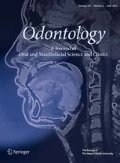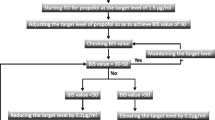Abstract
The propofol dose requirement and the emergence time are affected by antiepileptic use. The effects on anesthesia of the number and kind of antiepileptic agents have not been reported. We investigated the relationship between the kind and number of antiepileptic agents and the propofol dose requirement for anesthesia and emergence time in intravenous general anesthesia for dental treatment for patients with neurological disorders. We studied 247 patients with neurological disorders who underwent dental treatment under intravenous general anesthesia. Patients were categorized according to the number of antiepileptics (none, single agent, two kinds, and three or more kinds of antiepileptics) and the kind of antiepileptic (carbamazepine, valproate, phenobarbital, phenytoin, zonisamide, clobazam, or topiramate) being received. The propofol dose requirement for anesthesia, emergence time, and predicted blood propofol concentration at emergence were evaluated. Patients on three or more kinds of antiepileptics had significantly lower propofol dose requirement (reduction in 25%, compare with no use) and predicted blood propofol concentration at emergence (reduction in 41%) and significantly longer emergence time (extension in 50%) (P < 0.05). Valproate and clobazam reduced the propofol dose (valproate 9% and clobazam 19%) and predicted blood propofol concentration at emergence (valproate 18% and clobazam 33%), while phenobarbital increased these parameters (30% and 125%) (P < 0.05). The number and kind of antiepileptics effects propofol dose requirement. In particular, valproate and clobazam reduce the propofol dose requirement, while phenobarbital increases this.
Clinical trial registration UMIN No. UMIN000014179.

Similar content being viewed by others
References
Manley MC, Skelly AM, Hamilton AG. Dental treatment for people with challenging behaviour: general anaesthesia or sedation? Br Dent J. 2000;188(7):358–60.
Miyawaki T, Kohjitani A, Maeda S, Egusa M, Mori T, Higuchi H, et al. Intravenous sedation for dental patients with intellectual disability. J Intellect Disabil Res JIDR. 2004;48(Pt 8):764–8.
Asahi Y, Kubota K, Omichi S. Dose requirements for propofol anaesthesia for dental treatment for autistic patients compared with intellectually impaired patients. Anaesth Intensive Care. 2009;37(1):70–3.
Ouchi K, Sugiyama K. Required propofol dose for anesthesia and time to emerge are affected by the use of antiepileptics: prospective cohort study. BMC Anesthesiol. 2015;15:34.
Ouchi K, Fujiwara S, Sugiyama K. Acoustic method respiratory rate monitoring is useful in patients under intravenous anesthesia. J Clin Monit Comput. 2017;31(1):59–65.
Soehle M, Wolf CF, Priston MJ, Neuloh G, Bien CG, Hoeft A, et al. Comparison of propofol pharmacokinetic and pharmacodynamic models for awake craniotomy: a prospective observational study. Eur J Anaesthesiol. 2015;32(8):527–34.
Zhou SF, Zhou ZW, Yang LP, Cai JP. Substrates, inducers, inhibitors and structure-activity relationships of human cytochrome P450 2C9 and implications in drug development. Curr Med Chem. 2009;16(27):3480–675.
Sills G, Brodie M. Pharmacokinetics and drug interactions with zonisamide. Epilepsia. 2007;48(3):435–41.
Faucette SR, Wang H, Hamilton GA, Jolley SL, Gilbert D, Lindley C, et al. Regulation of CYP2B6 in primary human hepatocytes by prototypical inducers. Drug Metab Dispos. 2004;32(3):348–58.
Patsalos PN, Froscher W, Pisani F, van Rijn CM. The importance of drug interactions in epilepsy therapy. Epilepsia. 2002;43(4):365–85.
Yap KY, Chui WK, Chan A. Drug interactions between chemotherapeutic regimens and antiepileptics. Clin Ther. 2008;30(8):1385–407.
Andersson T, Hassan-Alin M, Hasselgren G, Rohss K. Drug interaction studies with esomeprazole, the (S)-isomer of omeprazole. Clin Pharmacokinet. 2001;40(7):523–37.
Nieto-Barrera M, Brozmanova M, Capovilla G, Christe W, Pedersen B, Kane K, et al. A comparison of monotherapy with lamotrigine or carbamazepine in patients with newly diagnosed partial epilepsy. Epilepsy Res. 2001;46(2):145–55.
Inoue T, Matsumoto R, Ikeda A. Treatment of epilepsy in patients of adolescence and adulthood. Nihon Rinsho. 2014;72(5):853–8.
Tsuji S. Clinical guidelines for epilepsy. Nihon Rinsho. 2014;72(5):803–8.
Hayashi T, Higuchi H, Tomoyasu Y, Ishii-Maruhama M, Maeda S, Miyawaki T. Effect of carbamazepine or phenytoin therapy on blood level of intravenously administered midazolam: a prospective cohort study. J Anesth. 2016;30(1):166–9.
Acknowledgements
I would like to thank Assoc Prof. Dr. Atsushi Kohjitani for his help with data collection, Prof. Dr. Kazuna Sugiyama for his help with study design, Prof. Dr. Takeshi Yokoyama for his help with manuscript reviewing, and Assoc Prof. Junji Kishimoto (statistician) for his help with data analysis.
Funding
This work was supported by the departmental research fund of Kagoshima University. The author has no financial relationships relevant to this article to disclose.
Author information
Authors and Affiliations
Corresponding author
Ethics declarations
Conflict of interest
The author has no conflicts of interest relevant to this article to disclose.
Additional information
Publisher's Note
Springer Nature remains neutral with regard to jurisdictional claims in published maps and institutional affiliations.
Rights and permissions
About this article
Cite this article
Ouchi, K. The number and kind of antiepileptics affect propofol dose requirement for anesthesia: observational study. Odontology 108, 102–108 (2020). https://doi.org/10.1007/s10266-019-00457-z
Received:
Accepted:
Published:
Issue Date:
DOI: https://doi.org/10.1007/s10266-019-00457-z




